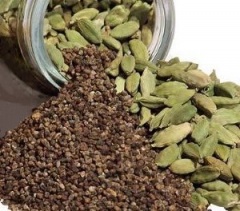Cardamom
| Infobox on Cardamom | |
|---|---|
| Example of Cardamom |  |
| Facts | |
| Origin |
|
| Stowage factor (in m3/t) |
|
| Humidity / moisture |
|
| Ventilation | See text |
| Risk factors | See text |
Cardamom
Description / Application
Cardamom (or cardamon) refers to several plants of the similar genera Elettaria and Amomum in the ginger family Zingiberaceae. Both genera are native to India, Nepal and Bhutan; they are recognised by their small seed pods, triangular in cross-section and spindle-shaped, with a thin, papery, outer shell and small black seeds. Today, Guatemala is the biggest producer and exporter of Cardamom in the world, followed by India. Some other countries such as Sri Lanka have also begun to cultivate it. Elettaria pods are light green while Amomum pods are larger and dark brown.
It is the world's third most expensive spice by weight, outstripped in market value only by saffron and vanilla.
Two varieties of the cardamom are available in the market: the green cardamom and the black cardamom. Both varieties feature three sided pods containing small black seeds which are arranged in vertical rows alongside a thin papery outer cover. The green cardamom has very strong flavour as well as it is more expensive than the black cardamom. Commonly, the seeds of the spice are used as additives in beverages like tea and coffee as they impart unique flavour and taste to these beverages.
Cardamom has a strong, unique taste, with an intensely aromatic, resinous fragrance. Black cardamom has a distinctly more smokey, though not bitter, aroma, with a coolness some consider similar to mint.
Cardamom , the queen of the spices, is widely used in pungent and sweet dishes to provide a strong aroma and flavour. In Ayurvedic medicine, this aromatic spice is considered as a very useful and effective medicine. Cardamom is a dried fruit of a plant and is indigenous to the Middle East, Scandinavia, and North Africa. The spice does more than just providing flavour to foods; it offers numerous health benefits ranging from being a digestive system tonic to its use as an essential oil in aroma therapy.
Green cardamom is one of the most expensive spices by weight, but little is needed to impart the flavour. It is best stored in pod form because once the seeds are exposed or ground, they quickly lose their flavour. However, high-quality ground cardamom seed is often more readily (and cheaply) available and is an acceptable substitute. Grinding the pods and seeds together lowers both the quality and the price. For recipes requiring whole cardamom pods, a generally accepted equivalent is 10 pods equals 1½ teaspoons of ground cardamom.
Shipment / Storage
In determining quality of cardammon, weight, colour (green or yellow), drying method (mechanical or sun) and the presence of burst fruit capsules (‘open pods’) are to be considered.
Green cardammon ("Greens") have the best shelf life, as the intact fruit capsule provides the best protection for the seeds. Unprotected seeds readily lose essential oil.
The fruits must contain at least 4% and the seeds at least 3% essential oil. Under optimal storage conditions, cardamom may be kept for a year.
It is mainly packed in poly-lined bagging material; black polybag liners being used for the better, green grades to protect them from light.
Particularly when unripe and in presence is warmth, cardammon is liable to loss in weight. Heat does not affect the value of the cardamoms.
Contact with moisture results in the outer shell becoming discoloured, mould growth may form with resultant depreciation. Because of strong odour cardamoms should not be stowed with coffee, tea and other delicate foodstuffs.
Favourable travel temperature range: 5 - 25°C; at temperatures of > 25°C, Essential Oils may be lost.
The product is to be stowed cool, dry and easy to ventilate. If the product is at "shipping dryness", it does not have to be ventilated during transport. Otherwise, the recommended ventilation conditions are an air exchange rate of 6 changes/hour (airing).
In the countries where they are cultivated, spices are dried, processed, cleaned, graded and packed for overseas dispatch. In consumer countries, they are delivered to spice mills, where they are cleaned and graded again, ready for sale in unground or ground form.
Risk factors
- Moisture damage
- Self-heating / Spontaneous combustion
- Odour
- Contamination
- Mechanical influences
- Shrinkage/Shortage
- Insect infestation / Diseases
- It is extremely expensive and a popular article for thieves, therefore arrange stowage aboard a ship in an inaccessible slot.











